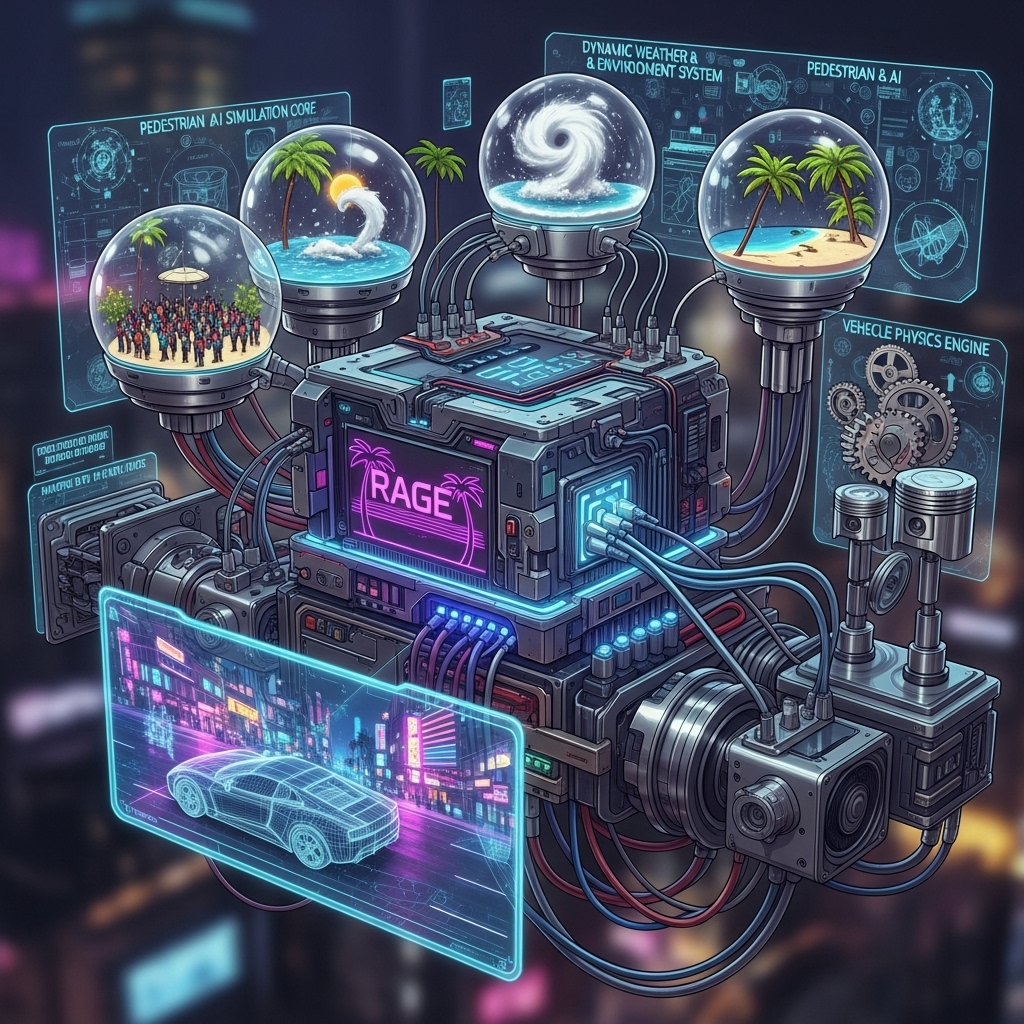The unveiling of a new Grand Theft Auto title is more than a significant event in the gaming industry; it is a cultural and technological inflection point. With each new entry, Rockstar Games has redefined the scale and fidelity of open-world entertainment. Grand Theft Auto VI appears poised to establish a new benchmark that will influence game development for the next decade. The initial footage reveals a cohesive ecosystem of interlocking technologies designed to achieve an unprecedented level of systemic realism.
This guide provides an authoritative, technical-but-accessible analysis of the groundbreaking technology powering Grand Theft Auto VI, deconstructing the four foundational pillars that enable this generational leap: the new RAGE 9 engine, the paradigm shift in real-time graphics, the sophisticated artificial intelligence, and the advanced physics simulations.
The Architecture of a New Generation: The RAGE 9 Engine
At the heart of Grand Theft Auto VI lies the latest iteration of Rockstar’s proprietary engine, the Rockstar Advanced Game Engine, or RAGE. The version powering GTA VI, unofficially dubbed RAGE 9, represents a fundamental architectural leap, designed from the ground up to harness the full potential of 9th-generation console hardware.
The Lineage of RAGE
The history of RAGE is a story of strategic necessity. After the engine behind the GTA III-era games was acquired by a competitor, Rockstar made the pivotal decision to invest in its own in-house engine. Its evolution can be charted through a series of landmark titles:
- Grand Theft Auto IV (2008): Introduced RAGE on a massive scale, integrating the Euphoria animation engine for procedural, physics-based character reactions.
- Grand Theft Auto V (2013): A monumental achievement, but the version of RAGE used was fundamentally designed for older, HDD-based 7th-generation hardware.
- Red Dead Redemption 2 (2018): This marked the debut of what can be considered RAGE 8, introducing a Physically-Based Rendering (PBR) pipeline and advanced volumetric effects, laying the groundwork for GTA VI.
RAGE 9: Architected for a New Paradigm
Grand Theft Auto VI is Rockstar’s first title built natively for the PlayStation 5 and Xbox Series X|S. The most critical architectural change is the move from a design centered around Hard Disk Drives (HDDs) to one built for Solid-State Drives (SSDs). The immense bandwidth of modern NVMe SSDs eliminates the data streaming bottlenecks of the past, enabling a world of unprecedented density, vast draw distances, and high-fidelity assets without immersion-breaking pop-in. This bespoke engine also gives Rockstar a significant advantage over developers using commercial engines like Unreal Engine 5, allowing for deep, “close to the metal” optimization tailored to the specific console hardware.
Rendering Vice City: A New Paradigm in Real-Time Graphics
The visual presentation of GTA VI represents a paradigm shift in real-time rendering, headlined by the full implementation of hardware-accelerated ray tracing.
The Foundation of Light: Ray-Traced Global Illumination (RTGI)
The most significant advancement is the implementation of Ray-Traced Global Illumination. This technique simulates the complex behavior of light as it bounces off surfaces to indirectly illuminate other objects. This process creates soft, diffuse, and physically accurate lighting with natural color bleeding—for instance, sunlight hitting a pink hotel facade will cast a subtle pink hue on the nearby pavement. Analysis by technical experts at Digital Foundry confirms its presence in nearly every shot, making objects feel truly part of the scene.
Reflections and The Human Element
RAGE 9 also utilizes ray tracing to generate physically accurate reflections on surfaces like car paint, glass, and water. This is complemented by a sophisticated Physically-Based Rendering (PBR) material system, allowing light to interact believably with every surface. Character rendering has also seen a massive upgrade, with a key innovation being the apparent use of a full, strand-based hair simulation, allowing for physically correct hair movement and lighting that is far more realistic than the “hair cards” used in traditional games.
The Ghost in the Machine: Simulating a Living, Breathing World
Beyond its graphics, GTA VI is poised to introduce a revolutionary approach to AI. Analysis of patents filed by Rockstar’s parent company, Take-Two Interactive, reveals technologies designed to transform non-player characters (NPCs) from reactive set dressing into proactive, persistent, and believable agents.
One cornerstone patent, “System and Method for Virtual Navigation in a Gaming Environment,” details a new system for NPC vehicle AI. This creates a far more sophisticated and realistic traffic simulation where NPCs have high-level situational awareness, unique driver profiles (from cautious to reckless), and can exist persistently in the world even when not on screen. Another patent for “Virtual Character Locomotion” moves beyond rigid animation trees, using a data-driven approach to blend modular animation “building blocks” in real-time to generate unique, context-aware movements.
The Physics of Reality: From Simulated Oceans to Deforming Steel
The final pillar is the deeply integrated physics engine. In RAGE 9, physics is elevated to a core gameplay pillar.
Perhaps the most ambitious aspect is its approach to water. Unconfirmed but persistent reports suggest a specialized team of engineers has been dedicated to creating a real-time fluid dynamics simulation capable of modeling complex phenomena like realistic, interactive waves and even dynamic tides. Vehicle physics have also been completely overhauled. Analysis of trailer footage reveals a sophisticated model grounded in real-world dynamics, including visible tire deformation under load, realistic suspension and body roll, and advanced, granular vehicle damage modeling. This is all enhanced by the returning Euphoria animation engine, providing procedural, physics-based reactions for characters.
Conclusion: Setting the Benchmark for the Next Decade
The technology powering Grand Theft Auto VI is a deeply integrated ecosystem designed to simulate a world with unprecedented fidelity. The RAGE 9 engine, architected for 9th-generation hardware, provides the raw power. The advanced graphics pipeline, revolutionary AI, and comprehensive physics simulation work in concert to generate emergent, unscripted, and dynamic gameplay. By prioritizing simulation depth and systemic realism, Rockstar is not just building a game; it is setting the technical and philosophical benchmark against which all future open-world experiences will be measured.

